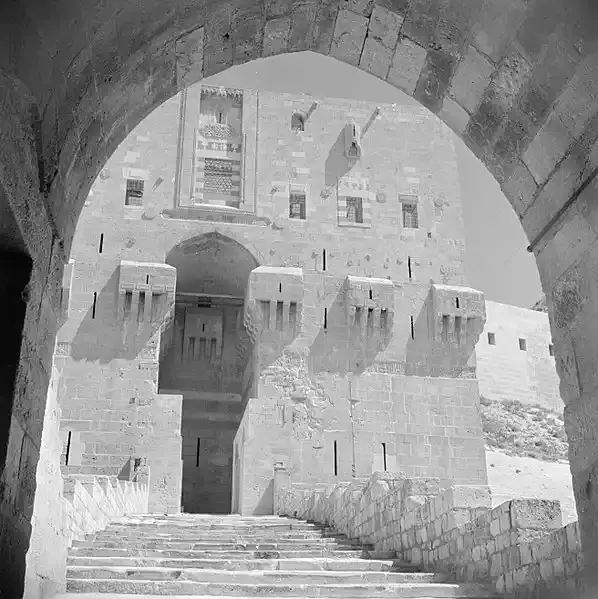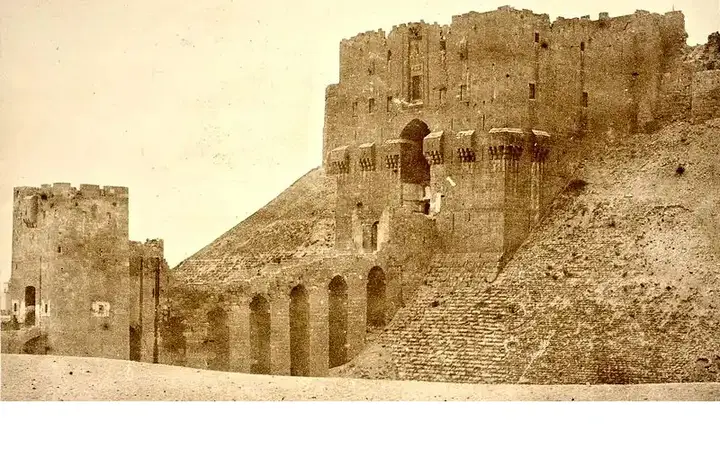The historic citadel of Aleppo ... One of the largest and oldest castles in the world
One of the oldest and largest castles in the world, Aleppo Citadel is a huge medieval fortified palace located in the center of the ancient city of Aleppo in northern Syria. People have used the castle hill since the middle of the third millennium BC. Occupied by many civilizations over time – including Armenians, Greeks, Byzantines, Ayyubids and Ottomans – most of what exists today is believed to originate from the Ayyubid period.
Show key points
- Aleppo Citadel, one of the oldest and largest castles in the world, is located at the heart of Aleppo and has been used since the third millennium BC.
- Throughout history, the citadel was occupied and modified by various civilizations including the Greeks, Byzantines, Ayyubids, and Ottomans.
- The castle served both religious and military purposes, transitioning from a temple to a fortress over different time periods.
- ADVERTISEMENT
- Damage from conflicts and natural disasters, such as earthquakes and invasions, necessitated major restorations at various times in its history.
- Today, the citadel is a prominent archaeological site within the UNESCO-listed Old City of Aleppo, attracting many visitors.
- The Mamluk-era throne hall, despite not fully surviving, is a key architectural and touristic highlight in the citadel.
- Restoration efforts have focused on preserving historical authenticity by using traditional materials and improving infrastructure like drainage systems.
History of the Citadel of Aleppo

Around the middle of the third millennium BC, a temple was established for the ancient capital on the hill on which the citadel of Aleppo was built. However, the first use of the hill as a fortress, in the form of a Macedonian Acropolis, was probably during the reign of Seleucus I Nicator in the fourth and third centuries BC. The castle was again developed to serve as a temple on the hill - this time dedicated to Zeus - visited by the Roman Emperor Julian in 64 BC. During the seventh century AD it is said that the inhabitants of Aleppo took refuge in the citadel because the walls of the city of Aleppo were in a deplorable state. Unfortunately, invading Muslim forces took advantage of this weakness in 636 CE, when Aleppo was conquered. Subsequent repairs of the castle were carried out after a major earthquake. In 944 CE, the Muslims under the leadership of the Hamdanid tribe conquered the city of Aleppo and made it their capital, which strengthened the status of the citadel of Aleppo and increased its illiteracy to protect the city to a large extent in 962 CE when the Byzantines attacked it. In 1260 the Mongols captured the citadel of Aleppo under Hulagu Khan and again in 1400 - this time under Timur. All buildings inside the
Recommend
Aleppo Citadel Today
The historic citadel of Aleppo remains an archaeological symbol in the city, part of the Old City of Aleppo that has been a UNESCO World Heritage Site since 1986. During 2010, the citadel suffered significant damage during the long battle of Aleppo. Since early 2017, with repairs to damaged parts, the citadel of Aleppo has been open to the public and boasts stunning views of the bustling Old City of Aleppo.
Getting to the citadel of Aleppo
You should check your government's travel advice before heading to Syria. However, Aleppo is only a 15-minute drive from Aleppo International Airport.
Front Throne Room in Aleppo Citadel

In 2007, the Aga Khan Heritage and Culture Authority (AKPA) returned the surviving Mamluk forecourt to the throne room. This rectangular court, with portals on the long sides and windows onto the castle, still provides access to the reconstructed throne room. The openings in the limestone walls are surrounded by polychrome marble and basalt, and the portal leading to the throne room has exquisitely carved coupler decorations. Atmospheric pollution has caused a deformed crust to appear on the limestone walls, which can lead to serious deterioration if left untreated. The stone walls were carefully cleaned, and the cracked stone blocks were repaired. The interior walls and front yard paving were improperly repaired with cement-based mortars, which were replaced by traditional lime-based materials. Finally, court drainage has been improved to prevent damage caused by the long-term presence of water.
The importance of the throne hall in the citadel of Aleppo
The throne hall was the most important Mamluk architectural contribution to the citadel of Aleppo. Although it did not survive in its original state, it remains one of the most visited spaces in the historic castle. The forecourt preserves the historical fabric from the Mamluk era and plays an important role in choreography to visit this magnificent audience room.
![]()
Nine mythical places that may have already existed: tracing the line between myth and reality
From Atlantis beneath the waves to El Dorado's golden allure and Shambhala's spiritual sanctuary, these legendary places continue to spark wonder. Though their existence remains unproven, ongoing discoveries and ancient clues keep the hope alive, blending myth with mystery in humanity’s quest for hidden truths. more- ADVERTISEMENT
![]()
Success Guide - How to Learn Project Management?
Success Guide - How to Learn Project Management more- ADVERTISEMENT
![]()
Surprising fact: The environmental impact of beef outweighs cars
Surprisingly, beef production harms the environment more than cars, mainly due to cows’ methane emissions and the massive resources needed to raise them. From deforestation to acid rain, the impact is huge. Cutting down beef consumption, even slightly, makes a big difference for the planet. more- ADVERTISEMENT
![]()
The Sahara Dilemma: Are Deserts Vital to the Balance of Our Planet?
Deserts may seem lifeless, but they are vital ecosystems rich in biodiversity and cultural heritage. From storing carbon to nourishing distant rainforests, they play a key role in Earth's balance. Despite harsh conditions, both nature and humans have adapted, proving deserts are far more than dry, empty land. more- ADVERTISEMENT
![]()
How to identify and transform a bad manager: lessons learned and the path to success
Bad managers hurt morale, kill productivity, and damage a company’s success. They micromanage, lack empathy, and avoid conflict, leading to high turnover and chaos. But the journey to becoming a good manager starts with self-awareness, better communication, and trust—turning toxic workspaces into thriving ones. more- ADVERTISEMENT
![]()
6 Things Expats Wish They Knew Before Moving to Hong Kong
Hong Kong’s street food scene is full of delicious surprises—think egg pancakes, wonton pasta, and authentic fish balls at wallet-friendly prices. If you’re feeling fancy, don’t miss the city’s Michelin-starred dim sum spots. more- ADVERTISEMENT
![]()
The Seven Years' War: A Global Conflict Defining a New Era
The Seven Years' War, fought from 1756 to 1763, was the first true global war, reshaping power across Europe, North America, and beyond. It marked Britain's rise as a colonial giant and set the stage for revolutions to come, with Frederick the Great and key battles leaving lasting impacts. more- ADVERTISEMENT
![]()
10 signs that you are mentally stronger than the average person: conclusions of psychology
Mentally strong people embrace change, stay optimistic, manage stress calmly, and bounce back from failure with confidence. Their self-discipline, emotional control, and ability to set healthy boundaries help them grow through challenges while maintaining strong, supportive relationships. more- ADVERTISEMENT
![]()
The best economical graphics cards for gaming and content creation - available in the Arab world
Looking for strong gaming and content creation performance on a budget? The NVIDIA GeForce GTX 1660 Super and RTX 3050 stand out for 1080p, while the AMD RX 6700 XT and NVIDIA RTX 3060 Ti shine at 1440p. Great value options packed with smooth performance and essential features like ray tracing. more- ADVERTISEMENT
![]()
7 physical cues that can help you read someone like an open book
Body language reveals more than words—handshakes, smiles, and even foot movements hint at confidence, stress, or honesty. A dominant handshake may suggest control; sincere smiles reach the eyes; fidgeting signals anxiety. Pay attention to these subtle cues, but always consider context—it's the key to truly understanding someone. more- ADVERTISEMENT





















